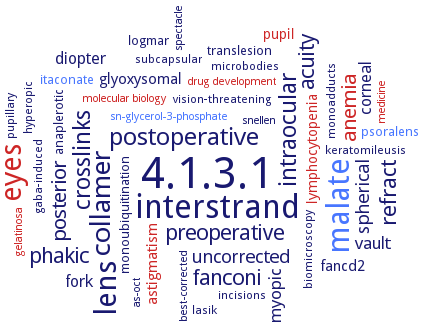4.1.3.1: isocitrate lyase
This is an abbreviated version!
For detailed information about isocitrate lyase, go to the full flat file.

Word Map on EC 4.1.3.1 
-
4.1.3.1
-
interstrand
-
malate
-
lens
-
eyes
-
collamer
-
postoperative
-
intraocular
-
crosslinks
-
refract
-
preoperative
-
phakic
-
acuity
-
fanconi
-
anemia
-
posterior
-
spherical
-
uncorrected
-
myopic
-
vault
-
fork
-
diopter
-
corneal
-
astigmatism
-
glyoxysomal
-
fancd2
-
pupil
-
lymphocytopenia
-
translesion
-
logmar
-
itaconate
-
anaplerotic
-
monoubiquitination
-
psoralens
-
monoadducts
-
gaba-induced
-
vision-threatening
-
pupillary
-
incisions
-
hyperopic
-
keratomileusis
-
subcapsular
-
lasik
-
microbodies
-
biomicroscopy
-
drug development
-
snellen
-
medicine
-
as-oct
-
best-corrected
-
sn-glycerol-3-phosphate
-
spectacle
-
molecular biology
-
gelatinosa
- 4.1.3.1
-
interstrand
- malate
- lens
- eyes
-
collamer
-
postoperative
-
intraocular
-
crosslinks
-
refract
-
preoperative
-
phakic
-
acuity
-
fanconi
- anemia
-
posterior
-
spherical
-
uncorrected
-
myopic
-
vault
-
fork
-
diopter
- corneal
- astigmatism
- glyoxysomal
-
fancd2
- pupil
- lymphocytopenia
-
translesion
-
logmar
- itaconate
-
anaplerotic
-
monoubiquitination
- psoralens
-
monoadducts
-
gaba-induced
-
vision-threatening
-
pupillary
-
incisions
-
hyperopic
-
keratomileusis
-
subcapsular
-
lasik
- microbodies
-
biomicroscopy
- drug development
-
snellen
- medicine
-
as-oct
-
best-corrected
- sn-glycerol-3-phosphate
-
spectacle
- molecular biology
- gelatinosa
Reaction
Synonyms
AceA, acuD, citrate lyase, D-threo-isocitrate: glyoxylate lyase, EgGCE, FPICL1, ICL, ICL1, ICL2, isocitrase, isocitratase, isocitrate lyase, isocitrate lyase 1, isocitrate lyase 2, isocitric lyase, isocitritase, lyase, isocitrate, MtbIcl, PDP, petal death protein, SSO1333, threo-DS-Isocitrate glyoxylate-lyase
ECTree
Advanced search results
Engineering
Engineering on EC 4.1.3.1 - isocitrate lyase
Please wait a moment until all data is loaded. This message will disappear when all data is loaded.
C165S/C247S
-
is inactivated by 5 mM GSSG and reactivated by treatment with either 20 mM reduced dithiothreitol or reduced glutaredoxin 1 as the wild-type protein. Complete shift in molecular mass corresponding to one glutathione adduct after 5 h of incubation, but prolonged incubation does not induce any additional glutathionylation
C165S/C247S/C301S
-
is inactivated by 5 mM GSSG and reactivated by treatment with either 20 mM reduced dithiothreitol or reduced glutaredoxin 1 as the wild-type protein. Complete shift in molecular mass corresponding to one glutathione adduct after 5 h of incubation, but prolonged incubation does not induce any additional glutathionylation
C247S
-
behaves as the wild-type. Complete shift in molecular mass corresponding to one glutathione adduct after 5 h of incubation, but prolonged incubation does not induce any additional glutathionylation
A214S
increased thermostability and low specific activity at low temperature
A214S
-
increased thermostability and low specific activity at low temperature
-
D475N
putative acetyl-CoA binding site of malate synthase, no malate synthase activity, but isocitrate lyase activity
R187K
putative acetyl-CoA binding site of malate synthase, no malate synthase activity, but isocitrate lyase activity
E423D
the mutant shows about 75% of wild type enzyme activity
E423D/E424D
the mutant shows about 60% of wild type enzyme activity
E424D
the mutant shows about 70% of wild type enzyme activity
F345A
the mutation leads to complete loss of the enzyme activity, compromises the enzyme stability, and modulates the structural dynamics and flexibility of the protein
H180A
the mutation leads to the destabilization and formation of inactive monomeric enzyme
F345A
-
the mutation leads to complete loss of the enzyme activity, compromises the enzyme stability, and modulates the structural dynamics and flexibility of the protein
-
H180A
-
the mutation leads to the destabilization and formation of inactive monomeric enzyme
-
E219A
site-directed mutagenesis of the highly conserved residue in the ICL subfamily 3 catalytic pattern, the mutant enzyme shows reduced activity compared to the wild-type enzyme
N214D
site-directed mutagenesis of the highly conserved residue in the ICL subfamily 3 catalytic pattern, the mutant enzyme shows 10fold reduced activity compared to the wild-type enzyme
Q211H
site-directed mutagenesis of the highly conserved residue in the ICL subfamily 3 catalytic pattern, the mutant enzyme shows reduced activity and elevated temperature optimum compared to the wild-type enzyme
Q221K
site-directed mutagenesis of the highly conserved residue in the ICL subfamily 3 catalytic pattern, the mutant enzyme shows reduced activity and elevated temperature optimum compared to the wild-type enzyme
T524V
the mutant shows increased Km and reduced kcat values compared to the wild type enzyme
T534A
the mutant shows reduced Km and kcat values compared to the wild type enzyme
additional information
truncated mutants: 13-573 (no isocitrate lyase activity, malate synthase activity), 566-1165 (no malate synthase activity), 20-573 (no isocitrate lyase activity, malate synthase activity), 38-573 (no isocitrate lyase activity), 20-1165 (isocitrate lyase activity and malate synthase activity), 38-1165
additional information
-
truncated mutants: 13-573 (no isocitrate lyase activity, malate synthase activity), 566-1165 (no malate synthase activity), 20-573 (no isocitrate lyase activity, malate synthase activity), 38-573 (no isocitrate lyase activity), 20-1165 (isocitrate lyase activity and malate synthase activity), 38-1165
additional information
transposition mutant PAO1SM::Himar1GmR is unable to grow on citronellol, n-octanol, leucine and acetate, and shows totally abolished ICL activity
additional information
-
transposition mutant PAO1SM::Himar1GmR is unable to grow on citronellol, n-octanol, leucine and acetate, and shows totally abolished ICL activity


 results (
results ( results (
results ( top
top






